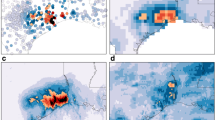Abstract
A new compound distribution model for extreme wave heights of typhoon-affected sea areas is proposed on the basis of the maximum-entropy principle. The new model is formed by nesting a discrete distribution in a continuous one, having eight parameters which can be determined in terms of observed data of typhoon occurrence-frequency and extreme wave heights by numerically solving two sets of equations derived in this paper. The model is examined by using it to predict the N-year return-period wave height at two hydrology stations in the Yellow Sea, and the predicted results are compared with those predicted by use of some other compound distribution models. Examinations and comparisons show that the model has some advantages for predicting the N-year return-period wave height in typhoon-affected sea areas.
Similar content being viewed by others
References
Cao, B., W, Y. G. and You, Z. J.., 2007. Comparison of distribution function for calculation of design wave height, Transaction of Oceanology and Limnology, (4): 1–9. (in Chinese)
Cheng, J. J. and Zhu, Z. X., 2010. Application of maximum entropy distribution in long-term wave height statistics, Journal of Shanghai Jiaotong University, 44(6): 839–843. (in Chinese)
Dai, D. J., Wang, W., Qian, C. C. and Sun, F., 2001. Surface elevation distribution of waves based on the maximum entropy principle, China Ocean Eng., 15(2): 217–228.
Dong, S., Song, Y. and Yang, Z., 2003. Statistical analysis of storm surge elevation considering seasonal variation, The Ocean Eng., 21(3): 68–72. (in Chinese)
Dong, S., Xu, P. J. and Liu, W., 2009. Long term prediction of return extreme storm surge elevation in Jiaozhou Bay, Periodical of Ocean University of China, 39(5): 1119–1124. (in Chinese)
Dong, S. and Yao, Y. J., 2010. Statistical analysis of design tide levels for coastal ports with maximum entropy distribution, Port Engineering Technology, 47(5): 6–8. (in Chinese)
Gao, L., 2007. A probability distribution for wave heights of non-rayleigh sea waves based on maximum entropy principle, Journal of Oceanography in Taiwan Strait, 26(3): 314–320. (in Chinese)
Jiang, J. T., Li, J. L. and Liu, D. F., 2008. The application of compound extreme value distribution in extreme value wind prediction of building engineering, Shanxi Architecture, 34(10): 1–3. (in Chinese)
Liu, D. F. and Ma, F. S., 1976. Extreme value distribution theory applied in estimating the years wave heights distribution, Acta Mathematicae Applacatae Sinica, 1(1): 23–37. (in Chinese)
Thomas, M. C. and Thomas, J. A., 1991. Elements of Information Theory, translated by RUAN Jishou, ZHANG Hua, 2005. Machinery Industry Press, Beijing.
Ulrych, T. J. and Bishop, T. N., 1975. Maximum entropy spectral analysis and autoregressive decomposition, Reviews of Geophysics and Space Physics, 13(1): 183–200.
Ulrych, T. J., 1972a. Maximum entropy power spectrum of long period geomagnetic reversals, Nature, 235, 218–219.
Ulrych, T. J., 1972b. Maximum entropy power spectrum of truncated sinusoids, J. Geophys. Res., 77(8): 1396–1400.
Wang, L. P., Dai, W. and Qi, Y., 2010. A new model estimation of extreme wave height, Periodical of Ocean University of China, 40(1): 54–58. (in Chinese)
Xu, D. L. and Yu, D. Y., 2001. Theory of Random Ocean Waves, Higher Education Publishing House, Beijing. (in Chinese)
Xu, D. L. and Zhang, J., 2004. Maximum entropy estimation of N-year extreme wave heights, China Ocean Eng., 18(1): 307–314.
Zhang, J., Ge, Y., Chen, H. Y. and Zhou, X. W., 2006. Maximum entropy estimation of T-year extreme wave-heights, Journal of Oceanography in Taiwan Strait, 25(2): 153–159. (in Chinese)
Zhang, L. Z. and Xu, D. L., 2004. A new maximum entropy probability function for the surface elevation of nonlinear sea waves, China Ocean Eng., 19(4): 637–646.
Zhou, L. M., Guo, P. F., Wang, Q. and Du, Y., 2004. Application of maximum entropy principle to studying the distribution of wave heights in a random wave field, China Ocean Eng., 18(1): 69–78.
Author information
Authors and Affiliations
Corresponding author
Additional information
This work was financially supported by the Open Fund of the Key Laboratory of Research on Marine Hazards Forecasting (Grant No. LOMF1101), the Shanghai Typhoon Research Fund (Grant No. 2009ST05), and the National Natural Science Foundation of China (Grant No. 40776006).
Rights and permissions
About this article
Cite this article
Wang, Lp., Sun, Xg., Lu, Kb. et al. A maximum-entropy compound distribution model for extreme wave heights of typhoon-affected sea areas. China Ocean Eng 26, 49–58 (2012). https://doi.org/10.1007/s13344-012-0004-6
Received:
Revised:
Accepted:
Published:
Issue Date:
DOI: https://doi.org/10.1007/s13344-012-0004-6




